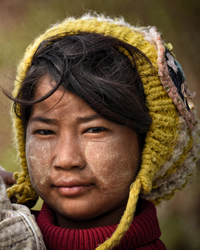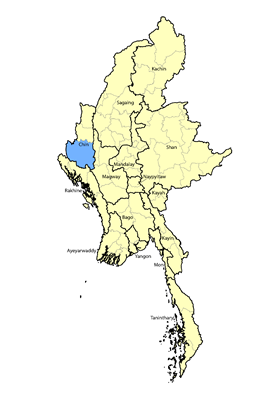The Kanise people were previously considered one of many dialect groups that make up the Eastern Khumi, but linguists have recently determined that the Kanise speak a distinct language. Ethnically, culturally, and historically, the Kanise see themselves as a cohesive people, but they have never appeared on any lists of people groups or languages until now.
Location: With a population of 3,500 people, the newly documented Kanise tribe inhabits 17 villages in and near the town of Sami in the Matupi District of southwest Chin State, near Myanmar's borders with Bangladesh and India. Their relatively small mountainous area is bordered by eight other Chin tribes, with the Asang Khongsa, Likhy, and Lemi to the north; Matu and Daai to the east; Hnise and Mro-Khimi to the south; and the Khumi to the west.
Language: The Kanise language is part of the Southern Chin branch of Tibeto-Burman languages. While the Burmese believe all ethnicities living within Myanmar ought to speak the national language, in practice, tribes like the Kanise “have had difficulty learning the Burmese language because there has not been extended contact with the Burmese, and there has been a shortage of teachers in the hills. Burmese institutions do not try to understand Chin people. Rather, they expect frontier people to understand them…. The Burman can easily communicate with the outside world, but he lacks basic knowledge of his own countrymen.”
A little-known tragedy occurred when thousands of Chin were recruited by the British to fight in the First World War. In 1916, about 4,000 young Chin men were sent to the frontlines in France and other parts of Europe. Many were killed and others traumatized as they struggled with the freezing conditions and barbarity of trench warfare. At the time, many Chin people were beginning to embrace Christianity, but the faith of many of the believers who were sent to fight was destroyed, and they returned home morally compromised and mentally broken. One source said: “They had endless tales of their adventures with the French women of the night. Before the Chin young men left for Europe, they had been certain that the sun rose out of the mountain ranges, but when they returned they were convinced the sun rose from the ocean.”
For centuries the Kanise have been expert hunters, feeding their families from the abundant wildlife in their densely forested homeland. In the past they used poison-tipped arrows with great effect, shooting deer, bears, and monkeys. Tigers, panthers, and elephants were generally killed when they fell onto sharp spikes in pits that hunters had carefully dug and concealed with leaves and branches.
Spirit worship was the dominant belief system of the Kanise for generations. The world was thought to operate with a delicate balance between spirits and people, and all care was taken not to offend demons that had the power to bring disaster and famine on communities. When Christianity began to flourish in the Kanise area in the 1950s and 1960s, hundreds of families gladly threw off the fear and bondage to demons their ancestors had lived under, and they found the Name of Jesus was powerful enough to protect and bless them.
The Gospel had a rocky start when demonic barriers began to be penetrated among many tribes in the Kanise area. One great breakthrough occurred in the 1980s when an Assemblies of God preacher named Tam Ki converted from animism and proclaimed that Jesus Christ is alive and more powerful than all spirits and false gods. One day as he preached in a village, “the people plotted to shoot and kill him. The bullet, however, did not leave the barrel of their weapon. The animistic villagers were so surprised that they all submitted to the Lord.” Although today almost all Kanise people profess faith in Christ, no Scripture or other Christian resources exist in their language.
Scripture Prayers for the Kanise in Myanmar (Burma).
| Profile Source: Asia Harvest |











